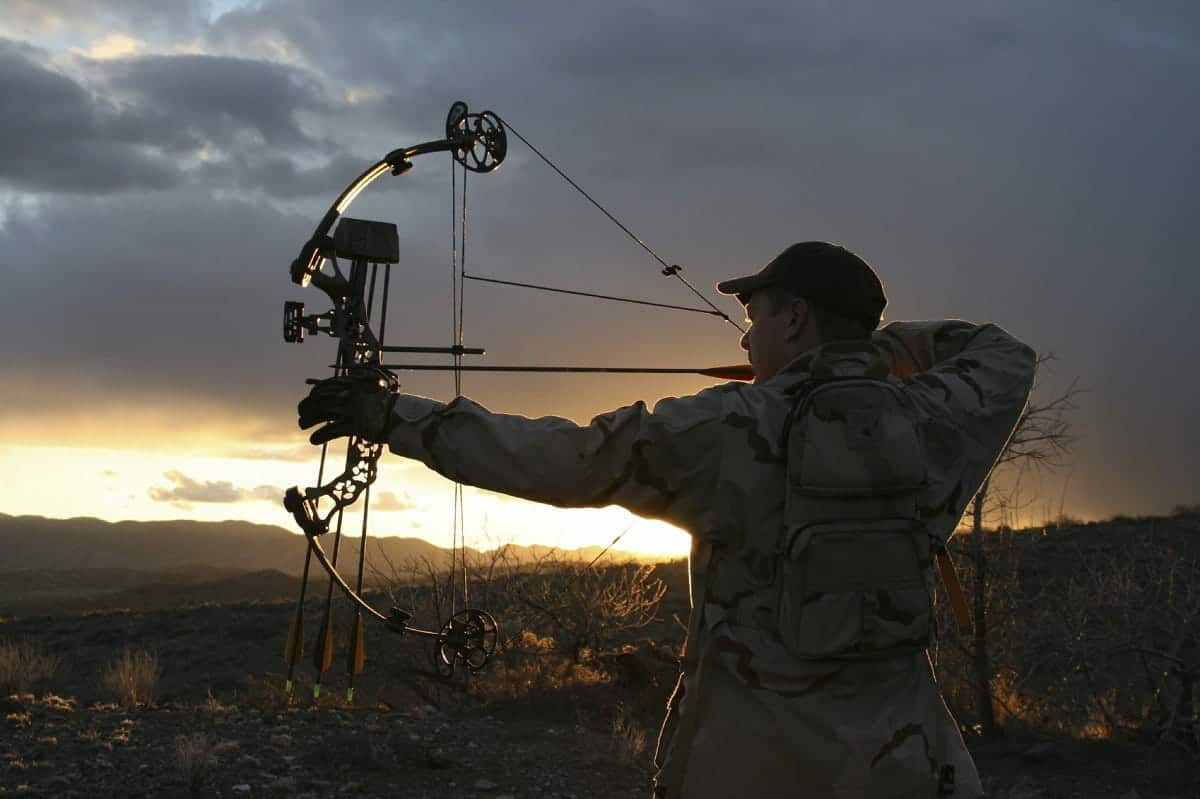The chainsaw has been around for more than a century (1). In that time it’s become an invaluable tool for landscapers, homeowners, construction companies and of course, the modern lumberjack. They allow for the fast, effective clearing of trees for roadwork, home construction and more. They enable landscapers to prune in a quick, effective manner.
They take the toil out of the preparation of firewood and they make the entire timber industry possible. They’re simple in concept, compact in design and affordably priced. And without them storm restoration would be a much more difficult process. Below, we’ve brought together the 10 best chainsaws currently on the market for your consideration.
1. Husqvarna 450 Gas Powered Chainsaw

We start our tour of the 10 best chainsaws with this 18 inch gas-powered beauty from Husqvarna. The 450 is small enough to take care of things like firewood and pruning but large enough to clear mid-sized trees with little effort. It’s relatively light at 11.3 pounds but has a powerful 50cc engine that takes no prisoners. When all that power is channeled through the 18 inch guide bar not much is going to stop it.
There’s a ton of torque, but because of the LowVib dampening system, very little vibration (2). The 450 features a low emissions engine, integrated chain brake and built in chain catcher to prevent injury in the event of a broken or derailed chain. Comes with a standard 2 year warranty that can be extended to 4 years.
2. Makita XCU03PT1 Chainsaw
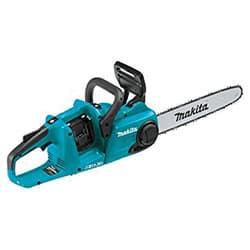
Makita understands that battery powered chainsaws come with a built in disadvantage: when the battery dies your chainsaw is useless. So they take the approach that “more is better”. And in this case they’re exactly right. While this is sometimes referred to as a “kit” it’s actually just the company’s excellent XCU03PT1 Chainsaw and 4 – yup, 4 – lithium-ion batteries, each of which takes about 45 minutes to recharge from empty.
That means that, as long as you’re working somewhere with power outlets, you’ll never have to worry about running out of battery power. The saw itself has a 14 inch guide bar which makes it a nice tool for landscapers and homeowners. It’s also light and provides power equivalent to a 32cc gas engine. Not bad for a battery job.
3. Husqvarna 460 24-Inch Chainsaw

The Husqvarna 460 is the big brother of the company’s outstanding 450 that we looked at above. It features a 24 inch guide bar and a slightly larger 60cc gas powered motor to handle both the increased chain weight and whatever it is you’re cutting with this beast. In addition, there’s a centrifugal air cleaning system that keeps big pieces of debris away from the air filter. And you get 3 chains with your purchase.
The 460 boasts outstanding torque (3) at every speed. It’s beautifully balanced to reduce wear and tear on your arms and shoulders. And while it’s a bit heavier than the 450 it’s also an alpha dog that isn’t backing down from the toughest job.
4. Poulan Pro PP4218A Chainsaw
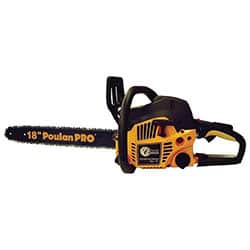
The Poulan Pro PP4218A is a lightweight but aggressive chainsaw that’s easy on you and tough on wood. It features a 42cc 2-cycle gas engine, an 18 inch guide bar and a quick start system that takes much of the drudgery out of working with a gas engine saw.
It also features what the company calls their “Super Clean Air Filtration” system that reduces much of the noxious debris that typically emanates from a gas saw. And it comes with an extra chain, gloves and a nifty carrying case. Landscapers with lots of wooded properties on their circuit will love this saw. It’s nimble enough for pruning and serious enough for all but the biggest trees. The 2 year warranty is a nice layer of icing on the cake.
5. Makita XCU02Z Cordless Chainsaw

If you’re looking for a tough but compact and convenient chain saw to handle the occasional job on your wooded lot, here it is. Landscaping companies are going to want to have one of these on hand as well for quick pruning jobs. And if you have a wood burning stove it will save you from long sessions at the chopping block.
The guide bar here is a modest 12 inches, which is actually perfect for light projects. It’s also a good size for people with little or no experience with a chain saw. The fact that it only produces 89 decibels makes it very neighbor-friendly. While the auto oiler and integrated chain brake make it both low maintenance and safe to operate.
6. WORX WG304.1 Chainsaw

The Worx WG304.1 is an outstanding value for those who might need a chainsaw for occasional light duty. This is a corded chainsaw which means you’ll be limited in as far as where you can use it. But if you just need something for around the yard or for firewood prep it’s a solid choice.
The 18 inch guide bar means it’s big enough for small trees, pruning and the aforementioned firewood. And the fact that it’s a fairly svelte 11 pounds means it’s not going to destroy your forearms to work with it over the course of an afternoon. The WG304.1 features built in chain brake, automatic oil lubrication and a patented auto-tensioning system that takes the guesswork out of chain adjustments. It’s ready to use right out of the box and there’s a 3 year warranty just for good measure.
7. Remington RM1425 Limb N’ Trim Corded Chainsaw
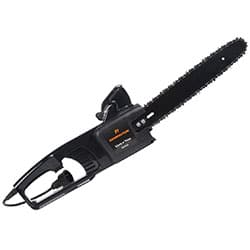
The name really says it all with this chainsaw. It’s perfect for light projects around the property including pruning limbs and trimming back those shade tree branches. It weighs a very forearm-friendly 6.25 pounds, has a 14 inch chain and starts up dependably with the push of a button.
There’s auto-lube, an auto-tensioner and an 8 amp motor that won’t bring down old growth forest but is ideal for the aforementioned trimming projects. You can even take care of your firewood prep. Although you’ll need to make sure you have a backup battery at the ready. Light, affordable and easy to use it’s ideal for the homeowner who likes to work in the yard.
8. Makita UC4051A 16″ Electric Chain Saw
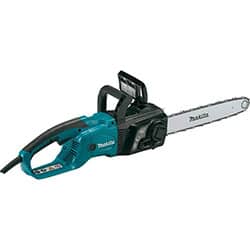
The UC4051A from Makita is a step up from the Limb N’ Trim. Which makes it a good choice for landscapers or homeowners who need to cut lots of firewood. Or who have lots of trees within spitting distance of the house. The 16 inch guide bar lets it take on medium sized trees and because it’s beautifully balanced it’s not going to turn your arms to jelly after 20 minutes.
The 14.5 amp motor gets the chain spinning at an impressive 2900 FPM. While the integrated limiter prevents the user from burning the motor out. There’s auto-oiling, comfortable grips, built-in chain brake for added safety and tool-less chain adjustment. If you live in the country you should have one.
9. ECHO CCS-58VBT Cordless Chainsaw

The Echo CCS-58VBT Cordless Chainsaw will accept a 16, 18 or 20 inch guide bar. That makes it one of the most versatile mid-level chainsaws out there. It’s also one of the lightest for its size, weighing in at a very modest 11.2 pounds. And it’s feature rich with its side access tensioner, automatic oiler, highly effective exhaust system and integrated chain break.
It does a great job speeding up firewood prep and landscapers will find themselves reaching for it again and again. The CCS-58VBT also boasts an effective vibration reduction system that saves your arms and extends the life of the saw in the process. And let’s not forget the industry best 5-year warranty.
10. Black+Decker LCS 1240 Cordless Chainsaw

The last item on our list of best chainsaws comes to us from Black+Decker. Their LCS 1240 sports a modest 12 inch guide bar and a 40 volt lithium-ion battery that’s good for 50 minutes or 60 cuts, whichever comes first.
It’s really light at just 8.3 pounds and it feels even lighter because it’s so well-balanced. There’s auto-oiling, tool-less tensioning and a wrap around handle that’s extremely comfortable and makes handling a breeze. With its modest price and dependable performance it’s a value winner.
FAQs
Corded, Gas Powered or Battery Powered?
When it comes to chainsaws you have 3 power options: gas-powered, corded and battery powered. Each has their advantages and disadvantages and which one you choose will depend largely on the circumstances of their use. That is, what you intend to cut, how much of it there is to cut and where the cutting will likely happen. Let’s take a closer look at the 3 power options now.
Gas – Gas powered chainsaws may require a bit of effort to start but once they’re powered up there isn’t much they can’t cut. They’re typically more powerful than electric powered chainsaws and, as long as you have enough gas with you, they’ll go wherever the wood is. In most cases you should get around an hour of continuous operation on a tank of gas. Sometimes more, sometimes a little less. But the term “gas-powered” is a bit deceptive, since they actually run on a gas/oil mixture (4) you either have to buy or prepare yourself.
Gas-Powered Pros
- No limit to their portability
- Still the most powerful option
- Only limit is the amount of gas you have with you
Gas-Powered Cons
- They pump out a lot of exhaust
- If you run out of the gas/oil mix you’re out of luck
- Starting them can be a chore
Corded – A corded chainsaw runs on electricity supplied by a power cord. That obviously implies that if you don’t have an outlet handy you’re out of luck. Guys harvesting trees don’t typically have the luxury of having an outlet nearby. So for them, the corded chainsaw is typically a non-starter. Nonetheless, there are still plenty of reasons someone may want a corded chainsaw. For instance, landscape companies almost always have one on hand. And people whose homes are on wooded lots will also likely find plenty of use for a corded chainsaw.
Corded Pros
- No noxious exhaust to deal with
- They’re typically much quieter than gas powered models
- They also typically require less maintenance
- No batteries to die or gas mixtures to buy
Corded Cons
- Not much use to commercial loggers
- They don’t have the power of a gas model
- You can’t use just any extension cord (5)
Battery-Powered – The battery powered chainsaw garnered plenty of snickers when it first hit the market. But few people are laughing today. Both available power and battery life have been greatly increased in recent years making them a viable alternative to corded chainsaws in some cases. Although they still aren’t powerful enough to appeal to hard-core loggers. For the most part they’re a nice tool for the homeowner or the landscaper to have on hand for occasional use.
Battery-Powered Pros
- Extremely portable
- Typically the lightest type of chainsaw
- Start in an instant and very quiet
Battery-Powered Cons
- The weakest of the 3 power options
- Batteries tend to run down pretty quick
- You have to remember to always have a spare battery charged and ready
When it comes to power options the choice you make will be driven in large part by how you plan to use the chainsaw. If you envision cutting large trunks in remote locations it’s gas power all the way. If you run a landscaping company, use the chainsaw regularly but have ready access to power outlets on your clients’ homes then corded is a good choice. If you want it just to clear brush in the yard and maybe do some pruning now and then a battery powered chainsaw should fit the bill.
How Long Should the Guide Bar Be?
A chainsaw isn’t much without a guide bar. And the length of the guide bar is one of the most important considerations when selecting a chainsaw. As a general rule the longer the guide bar the more power you’ll want from your motor. Simply because longer chains are heavier. The length of the guide bar will be driven by the intended use of the chain saw. If it’s too short you may find yourself unable to perform your duties. If it’s too long it can be a safety hazard when cutting small objects.
Guide bars tend to vary in length from about 8 inches to as much as 30 inches. (Some guide bars commercial loggers use can be longer than that.) The super short guide bars are used almost exclusively for light work such as pruning. Most guide bars however, tend to be in the 16 to 24 inch range. Here are some things that should help you choose the right length.
16 to 20 Inch Guide Bars – 16 to 20 inch guide bars are considered mid-level. They’ll cut plenty of wood as long as it’s not too thick. This size guide bar is considered the outer limits of what’s practical for pruning and small scale work. But they’re fine for cutting firewood and storm cleanup. If you have little or no experience with a chainsaw this size may be a bit much to learn on. We’d recommend starting smaller and working your way up.
16 to 20 Inch Pros
- Can handle bigger jobs with relative ease
- No problem cutting down mid-size trees
- Good for cutting firewood
16 to 20 Inch Cons
- May be too big for beginners
- Too big for finesse work
- Requires a bigger motor and more power
20 to 24 Inch Guide Bars
Once you get past 20 inches you’re talking about the kind of lengths professionals rely on. A 24 inch chainsaw can cut 95% of the trees on planet earth and do so without breaking too much of a sweat. And for the record, you’re also talking gas chainsaws with lots of power that can make use of that long chain. That said, few are the situations where a homeowner – or even a landscaper for that matter – will need anything longer than a 20 inch guide bar.
20 to 24 Inch Pros
- The ability to take down any size tree in your path
- Saves your forearms a lot of work
- Enables you to keep moving
20 to 24 Inch Cons
- Too big for around the house
- Dangerous for inexperienced users
- Adds a lot of weight to the chainsaw
As we mentioned earlier you can find 30 inch or even bigger guide bars. But anything that large is really a specialty item and not intended for everyday use.
What Safety Features are Available?
Chainsaws are extremely dangerous tools that can yield deadly consequences if not handled properly. Chainsaw manufacturers are not blind to the risks involved and have worked diligently to make these tools as safe as can be. That includes integrating certain safety features, including:
- The Chain Brake – The chain brake is an incredibly important safety feature designed to bring the rotating chain to a quick stop should it be necessary. There are typically two ways the chain brake is activated. The first is by pushing the top handle forward should you feel the need to stop the chain for whatever reason. In such cases the chain will usually come to a complete stop in less than a second. The other way the chain brake is engaged is during a kickback event (6). This type of emergency braking is crucial in order to stave off serious injury should the operator’s hand become dislodged during a violent kickback.
- The Chain Catcher – When a chain breaks there is always the risk it may fly back toward the operator. To prevent this from happening most saws offer a chain catcher that stops the chain from flying away in the event it breaks or becomes derailed. The process can be loud and jarring but it’s also effective at preventing serious injury.
- The Safety Throttle – The safety throttle is designed to prevent the chain from being accidentally activated should something hit the trigger. It usually takes the form of a second trigger located on the chainsaw’s rear handle. This dual trigger design might seem like overkill, but if you’re operating in heavy underbrush it could save your bacon. It could also save the life of an unsuspecting family member who accidentally contacts the trigger for whatever reason.
We recommend reading the OSHA guide to chainsaw safety (7) if you’ve never used a chainsaw before.
What are the Warning Signs of a Dull Chain?
Even the sharpest, highest-quality chainsaw chain will become dull over time. Here are some warning signs that the chain needs sharpening or replacing (8):
- You need to physically push the saw into the wood when making a cut. With a sharp chain you would feel the saw being pulled into the wood.
- The chain pulls to one side creating a crooked cut. This is normally a sign that the teeth on one side of the chain have become dull.
- The cutting action is not smooth. Instead the saw rattles and shakes as it cuts through the wood.
- You see smoke coming from the cut even though the saw should be handling it with ease.
The Bottom Line
The best chain saws are incredible tools that make short work of difficult jobs. But they’re not toys and not all are created equal. You should never purchase a chainsaw based solely on price. Instead you should weigh the reasons you need it, how you plan to use it and how frequently you think you’ll be using it. You should also consider which type of power is right for your purposes. And don’t forget to make sure your chainsaw comes with some basic safety features. If you can get an inexpensive chainsaw that meets all your criteria, great. Chainsaws are a great alternative to a folding saw, but don’t buy one simply because it’s cheap.


